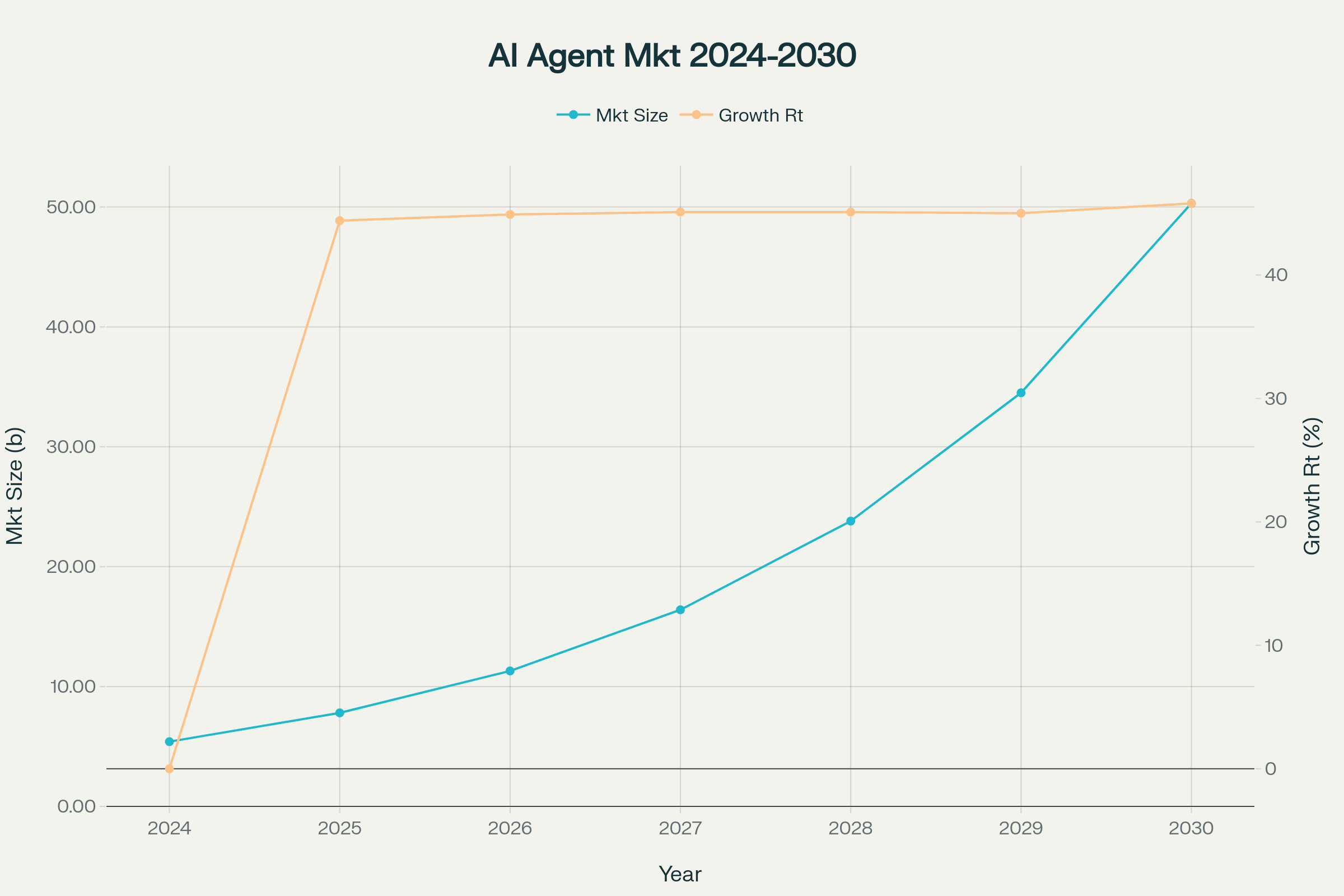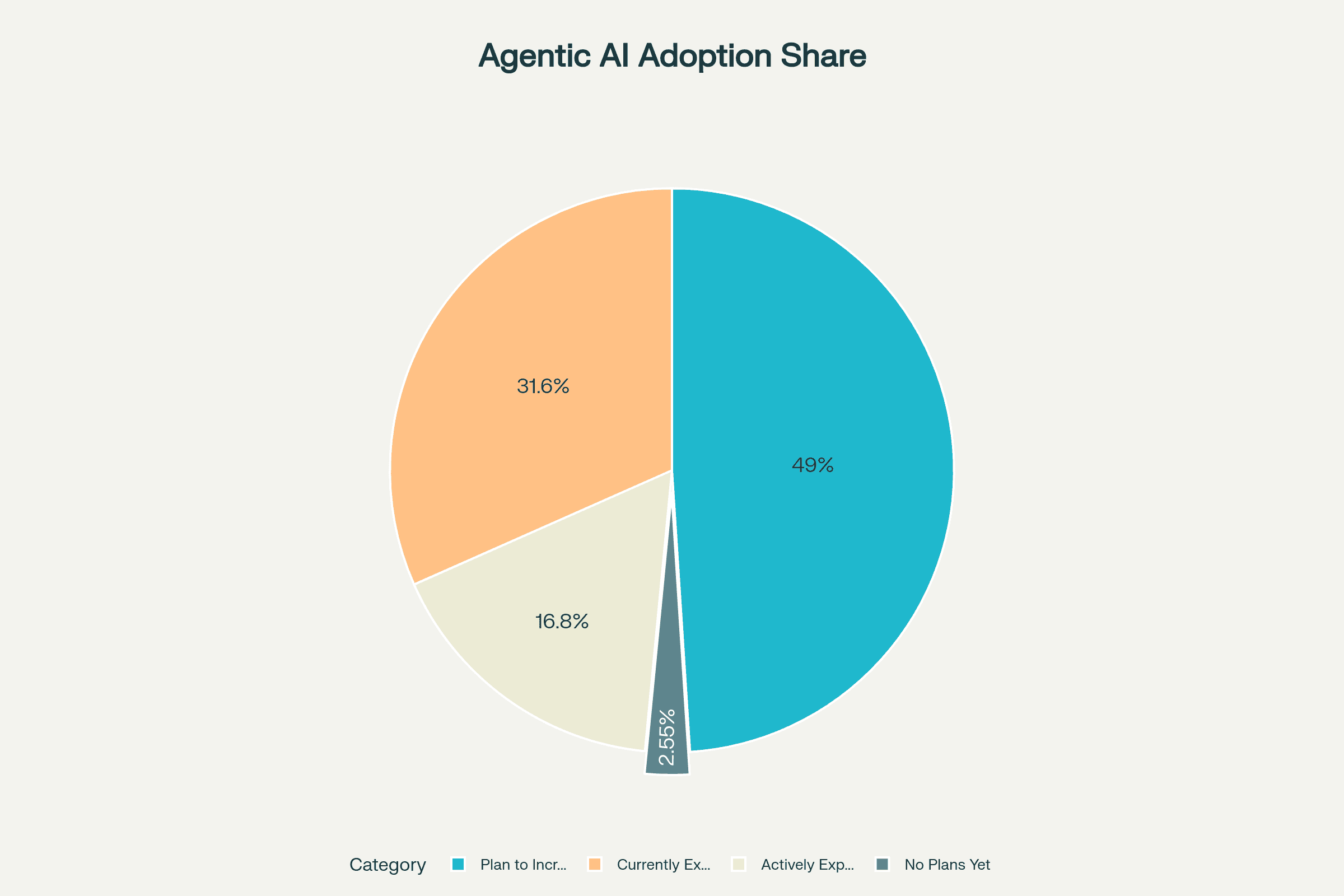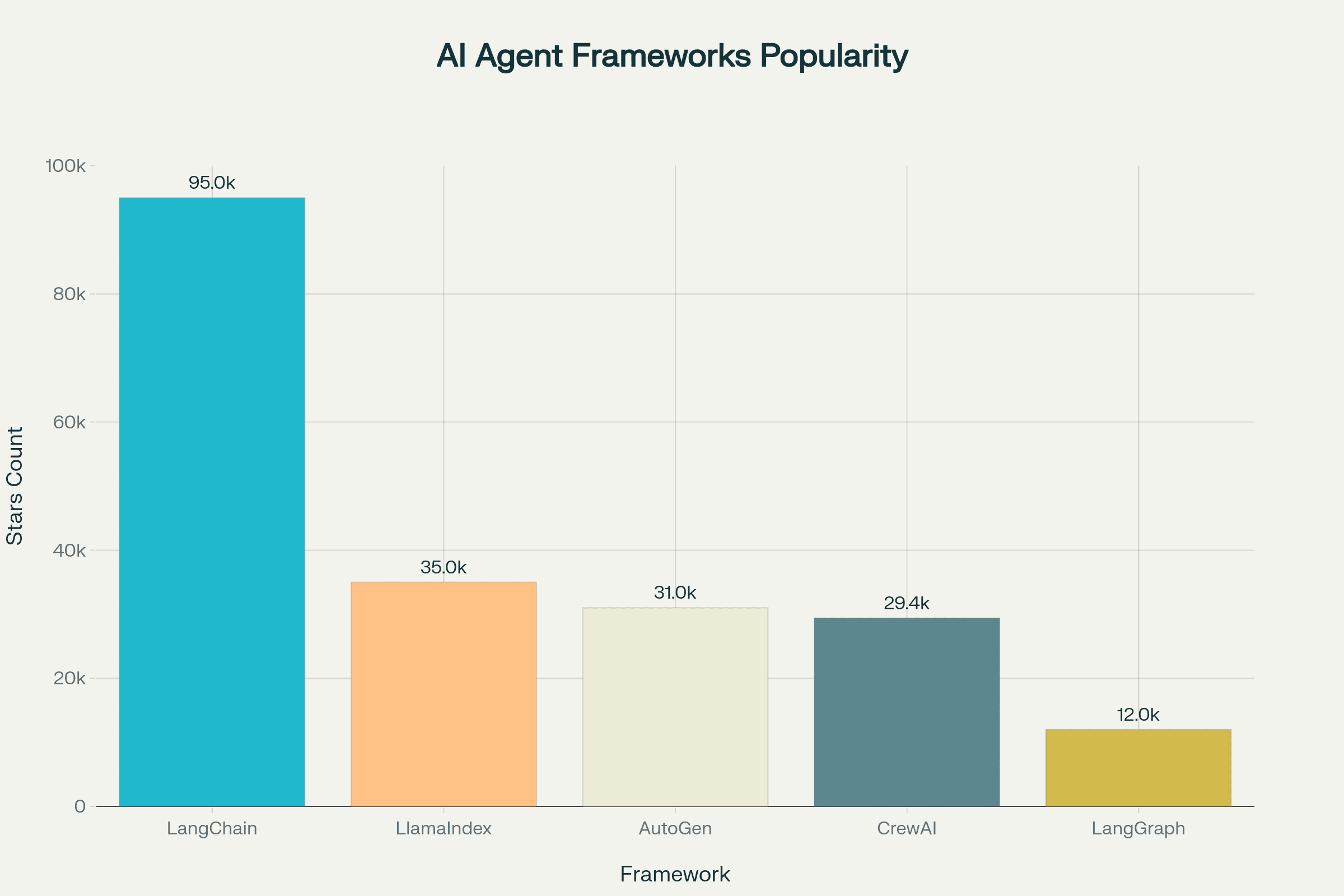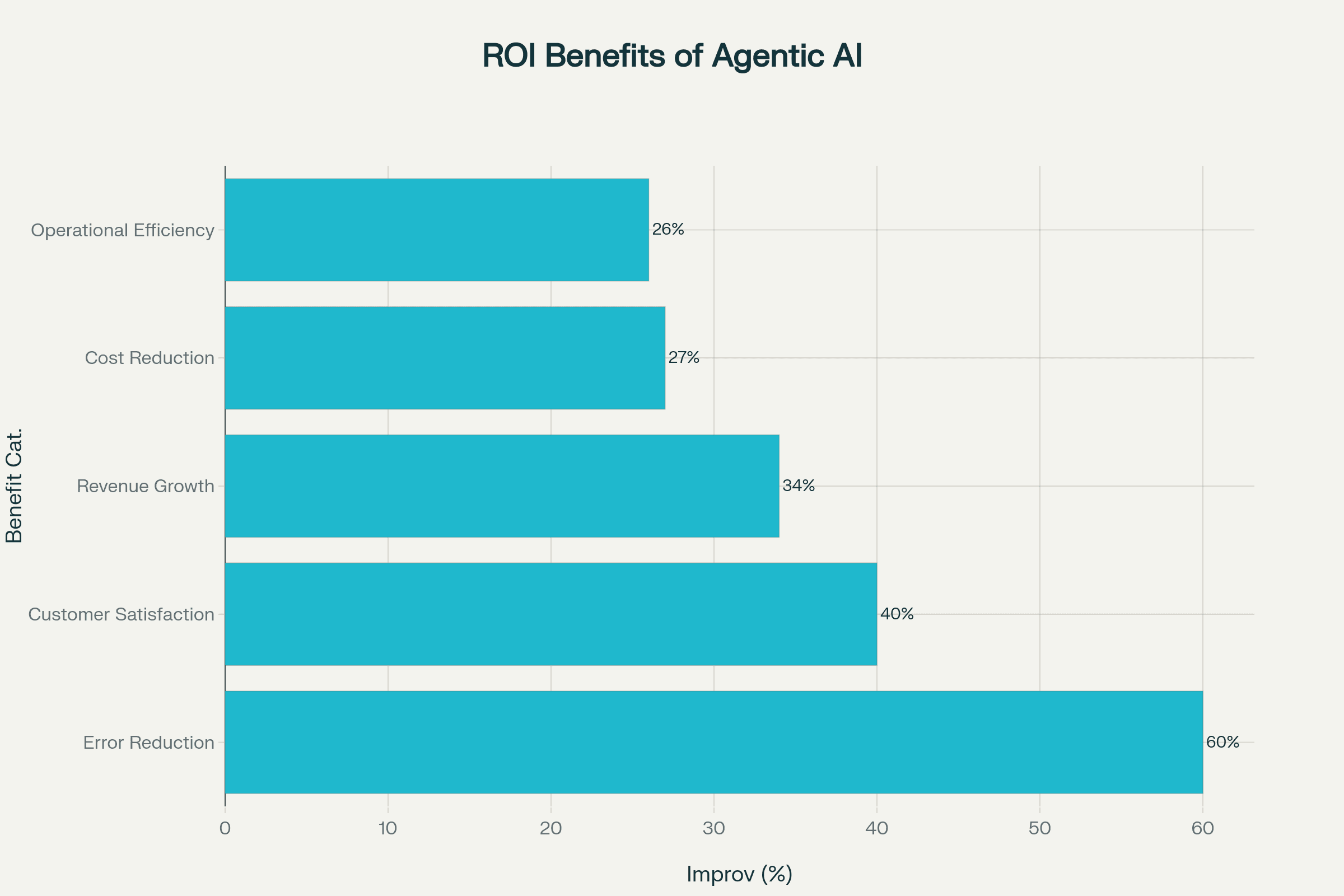
Sarthak Tyagi
Web Developer | AWS Cloud Architect
.webp)
Explore Agentic AI's definition, core components, and leading frameworks like CrewAI, LangChain, and AutoGen. Learn how autonomous AI agents are transforming enterprises with 45.8% market growth and comprehensive implementation strategies.
Agentic AI represents a fundamental paradigm shift in artificial intelligence, moving from passive, prompt-driven systems to autonomous, goal-oriented agents that can plan, learn, and execute complex tasks with minimal human intervention. Unlike traditional AI systems that require explicit instructions for every action, agentic AI systems operate independently, making decisions and adapting to changing environments to achieve specific objectives.
The term "agentic" refers to these models' agency, or their capacity to act independently and purposefully. This revolutionary approach enables AI systems to function as autonomous digital employees, capable of understanding context, developing strategies, and taking action based on preset goals.

AI Agents Market Growth Projection (2024-2030)
Agentic AI is an artificial intelligence system that can accomplish specific goals with limited supervision, consisting of AI agents that mimic human decision-making to solve problems in real time. These systems exhibit three fundamental characteristics that distinguish them from traditional AI:
Agentic AI systems possess several core capabilities that set them apart from conventional AI models:
Decision-Making Loop: Autonomous agents operate through a structured process of perceive, process, and act. They gather input from their environment via sensors, APIs, or user interactions, analyze this data using models such as neural networks, and execute actions through actuators, APIs, or user interfaces.
Memory Systems: Unlike stateless traditional AI models, agentic systems incorporate both short-term and long-term memory capabilities. Short-term memory functions as a buffer for immediate context and enables in-context learning, while long-term memory is implemented through external vector databases for storing and retrieving historical patterns.
Tool Integration: Agentic AI systems can interface with external tools, including code interpreters, web search utilities, mathematical calculators, and various APIs, enabling them to execute planned actions and turn abstract strategies into concrete results.
Self-Correction and Reflection: These systems possess the capability to evaluate their own performance, identify errors or inefficiencies in their approach, and adapt their strategies accordingly.
The distinction between these AI paradigms is crucial for understanding when to implement each approach:
| Feature | Traditional AI | Generative AI | Agentic AI |
|---|---|---|---|
| Primary Function | Focused on automating repetitive tasks | Content generation (text, code, images) | Goal-oriented action & decision-making |
| Autonomy | Low – Relies on specific algorithms | Variable – May require user prompts | High – Operates with minimal human oversight |
| Decision-Making | Relies on explicit instructions | Responds to prompts | Makes decisions autonomously |
| Memory | Minimal or no memory of past interactions | Limited context window | Retains and uses memory to refine actions |
| Learning | Limited or requires manual retraining | Based on training data | Continuously learns and adapts from experience |

Enterprise Agentic AI Adoption Status
Modern agentic AI systems are built upon seven fundamental components that work together to enable autonomous operation:
This component defines high-level objectives and breaks them into actionable units. Agentic systems require a goal management layer that tracks what the agent is ultimately trying to achieve and decomposes that goal into subtasks or milestones using planning algorithms such as hierarchical task networks (HTNs).
The perception module handles all incoming information, processing data from various sources including user inputs, environmental sensors, APIs, and databases. This continuous data ingestion creates real-time understanding of system states and operational patterns.
Planning mechanisms represent sophisticated cognitive frameworks that enable AI agents to think strategically about future states, anticipate potential challenges, and develop comprehensive approaches to achieving optimal performance. Advanced planning algorithms allow agents to:
Memory systems in agentic AI operate on multiple levels:
Short-term Memory: Maintains immediate awareness of current system states, active processes, and ongoing tasks while processing real-time data streams.
Long-term Memory: Serves as the institutional knowledge repository, storing historical performance data, successful strategies, learned patterns, and accumulated expertise about specific environments.
Episodic Memory: Allows agents to recall specific incidents, events, and their outcomes, creating a rich database of experiential knowledge.
This framework translates cognitive insights into practical interventions, managing everything from automated configuration changes and resource scaling to incident response coordination and preventive maintenance scheduling.
Reinforcement learning is essential in assisting agentic AI in making self-directed choices by supporting agents in learning optimal actions through trial-and-error methods. Agents continuously explore their surroundings and receive rewards or punishment for their actions, refining their decision-making capabilities over time.
Agentic systems can leverage external resources such as APIs, databases, and other knowledge bases to enhance performance. They also enable communication between multiple agents in multi-agent systems.
Multi-agent systems (MAS) distribute tasks and communication among individual agents, each bringing specialized expertise to collectively achieve goals and learn in a shared environment. There are several architectural approaches:
Centralized Architecture: A single server controls agent interactions and information, with an orchestrator reasoning over the overall process and system. This approach simplifies communications and standardizes information but can create a single point of failure.
Decentralized Architecture: Agents control their own direct interactions with each other instead of relying on a central controller. This approach is more robust and scalable but requires more complex coordination.
Hierarchical Architecture: A multi-level system with supervisors of supervisors, allowing for more complex control flows and specialized management at different organizational levels.
The AI agent framework landscape has evolved rapidly, with several platforms emerging to simplify the development and deployment of agentic systems. Here's an in-depth analysis of the leading frameworks:

Popular AI Agent Frameworks by GitHub Stars
CrewAI stands out as a lean, lightning-fast Python framework built entirely from scratch, completely independent of LangChain or other agent frameworks. It empowers developers with both high-level simplicity and precise low-level control for creating autonomous AI agents.
Role-Based Agent Design: CrewAI treats AI systems like a company with departments working together under leadership. Each agent has specific roles (researcher, writer, analyst), goals, and backstories to enable specialized expertise.
Task Delegation: Built-in mechanisms for autonomously assigning tasks to appropriate agents based on their capabilities, with sequential or parallel workflow execution.
Collaborative Intelligence: Framework for autonomous inter-agent communication and knowledge sharing without human mediation, enabling agents to work together seamlessly.
Process Management: Structured workflows for sequential and parallel autonomous task execution, with the crew managing overall operations while individual agents focus on specialized tasks.
CrewAI excels in scenarios requiring collaborative problem-solving with dynamic task delegation. It's ideal for:
LangChain serves as the foundational framework for developers working with LLMs, focusing on creating straightforward, linear workflows where tasks flow sequentially. It has become the most popular choice with 95,000 GitHub stars.
Modular Architecture: LangChain emphasizes modularity, allowing developers to swap components and adjust workflows without major code restructuring. It provides abstractions for chains, tools, agents, and memory.
Extensive Integration: Native integration with multiple LLMs including OpenAI, Anthropic, and Hugging Face models, plus comprehensive tool integration capabilities.
Rapid Prototyping: Excellent for quick setup and deployment of linear tasks without extensive coding requirements.
LangChain excels in:
LangGraph represents a significant evolution in LLM application development, implementing a sophisticated graph-based system that handles complex, interconnected workflows. Built on top of LangChain, it addresses limitations of traditional chain-based approaches.
Graph-Based Architecture: Unlike LangChain's linear approach, LangGraph uses a full graph structure supporting loops, cycles, and dynamic routing between nodes based on conditions.
State Management: Central state management where every node can read and write to shared state, making it easy to track progress and adjust behavior dynamically.
Complex Control Flow: Built-in support for retries, branching logic, loops, and conditional routing without requiring workarounds.
Human-in-the-Loop: Excellent support for workflows requiring human intervention, approval processes, or multi-step decision trees.
LangGraph shines in:
Microsoft AutoGen exemplifies a conversational approach to multi-agent systems, treating complex workflows as dialogues among multiple agents. With 31,000 GitHub stars, it has gained significant traction in the developer community.
Conversation-Driven Approach: AutoGen treats complex workflows as dialogues among multiple agents, each capable of sending and receiving messages to drive tasks forward.
Modular and Layered Design:
Conversable Agents: Agents can communicate with each other and with humans through natural language, with built-in types like AssistantAgent for AI-powered tasks and UserProxyAgent for human interaction.
Custom Agent Behaviors: Extensive customization through the register_reply function, specifying how agents respond to specific triggers or keywords.
Tool Integration: Seamless integration with predefined tools and functions through LLM configuration and function registration.
Multi-Language Support: Python and .NET interoperating agents with plans for additional language support.
AutoGen excels in:
| Framework | Best For | Complexity Level | Primary Strength |
|---|---|---|---|
| CrewAI | Team-based collaboration | Medium | Role-based multi-agent coordination |
| LangChain | Linear workflows & RAG | Low-Medium | Rapid prototyping & extensive integrations |
| LangGraph | Complex state management | High | Graph-based workflow control |
| AutoGen | Conversational agents | Medium-High | Natural language agent interactions |
| LlamaIndex | Data-intensive applications | Medium | Advanced data integration & indexing |
The agentic AI market is experiencing unprecedented growth, with projections showing expansion from USD 5.4 billion in 2024 to USD 50.3 billion by 2030, representing a remarkable CAGR of 45.8%. This explosive growth is driven by increasing demand for automation, advancements in Natural Language Processing, and rising demand for personalized customer experiences.
Enterprise adoption is accelerating rapidly, with 62% of global enterprises currently experimenting with agentic AI agents, ranging from proof-of-concepts to scaled pilots. Additionally, 88% of enterprises indicate intent to dedicate specific AI budgets toward agentic systems in 2025.
Organizations implementing agentic AI report significant improvements across multiple performance metrics:

ROI Benefits and Performance Improvements from Agentic AI Implementation
Operational Efficiency Gains: Companies experience 3-5x improvements in process completion times for complex workflows, with 26% of enterprises seeing substantial operational efficiency improvements. Tasks that previously required multiple handoffs between departments now happen automatically.
Cost Reduction: Organizations pairing agents with intelligent virtual assistants handle 7.7% more simultaneous chats, resulting in average staffing cost savings. Companies experience a 27% reduction in average handle time after implementing AI-powered applications.
Revenue Growth: 63% of enterprises experience revenue increases of up to 10% or more, with organizations measuring AI tool impact reporting a 34% increase in revenue and 40% improvement in client ratings.
Error Reduction: Agentic AI delivers up to 60% reduction in human errors by autonomously triaging and resolving issues, freeing employees to focus on more complex tasks.
Enhanced Customer Experience: Agentic AI revolutionizes customer interactions by providing personalized and responsive experiences at scale. AI agents can infer customer intent, predict needs, and offer tailored solutions while operating 24/7.
Human Augmentation: Rather than replacing people, agentic AI systems enhance human performance, productivity, and engagement. Strategic collaboration between AI agents and people expands enterprises' capacity to tackle complex challenges.
Scalability Without Linear Growth: Unlike traditional workflows that hit bottlenecks as volumes rise, agentic agents scale horizontally without requiring proportional increases in headcount.
Infrastructure Requirements: Agentic AI systems demand substantial computational power, requiring high-performance GPUs and TPUs for AI model execution. Organizations need scalable cloud services that support auto-scaling to manage varying computational demands.
Data Quality and Governance: Unlike traditional AI systems, agentic AI operates with dynamic, autonomous access to various tools and databases. This requires robust data privacy frameworks and quality assurance mechanisms.
Integration Challenges: The technical architecture consists of three primary modules - perception, cognitive, and action - each requiring seamless integration with existing enterprise systems.
Unpredictable Execution: For CISOs, agentic AI presents a complex challenge - systems that can write code, schedule actions, make purchases, or expose vast amounts of data, all without deterministic, traceable commands.
Access Control: Agentic systems need strict output filtering, fine-grained access control, and continuous monitoring to detect behavior drift or prompt manipulation.
Regulatory Compliance: In regulated sectors like banking, healthcare, or insurance, organizations need robust frameworks to ensure agentic AI operations comply with industry standards.
Talent and Training: Organizations face critical hurdles in building teams with the necessary skills to develop, deploy, and maintain agentic AI systems effectively.
Change Management: Trust remains the central barrier to AI agent adoption, with organizations needing to establish confidence in autonomous decision-making systems.
ROI Measurement: Organizations need to develop new KPIs for measuring agentic AI success, including first contact resolution, customer satisfaction scores, and operational throughput metrics.
Clinical Decision Support: Agentic AI has powerful implications for healthcare operations, providing autonomous diagnostic assistance and treatment recommendations based on patient data analysis.
Patient Management: AI agents handle patient queries, assist in appointment scheduling, and offer health guidance, contributing significantly to streamlined healthcare operations.
Telemedicine Enhancement: Healthcare organizations use agentic AI to automate patient intake, symptom assessment, and care coordination across multiple providers.
Real-Time Fraud Detection: Financial institutions deploy agentic AI for autonomous fraud detection and prevention, analyzing transaction patterns and making immediate risk assessments.
Investment Decision Making: Agentic AI systems analyze market trends, assess investment opportunities, and create personalized financial plans for individual clients.
Claims Processing: Insurance companies leverage agentic automation to streamline claims processing, with AI agents assessing claim validity, gathering necessary information, and even creating communications to customers.
Predictive Maintenance: Agentic AI solutions help avoid downtime and service disruptions with predictive maintenance that addresses problems before they become critical.
Supply Chain Management: In logistics, agentic systems predict disruptions, adjust logistics, and optimize inventory without human intervention, yielding significant cost savings and efficiency gains.
Quality Control: Manufacturing environments use agentic AI for autonomous quality inspection and process optimization.
Next-Generation Virtual Agents: Agentic AI powers virtual agents that go far beyond scripted chatbots, capable of tracking ongoing customer issues over time, escalating to human support when needed, and querying databases to take actions like issuing refunds.
Omni-Channel Support: AI agents handle client queries across multiple platforms, boosting customer satisfaction and loyalty through consistent, personalized experiences.
Proactive Problem Resolution: Advanced agents identify potential customer issues before they escalate, enabling proactive outreach and problem resolution.
Advanced Reasoning Capabilities: Future agentic AI systems will demonstrate enhanced reasoning abilities, moving beyond current pattern recognition to more sophisticated logical inference and creative problem-solving.
Multimodal Integration: Emerging capabilities for handling text, image, audio, and video will enable comprehensive autonomous agent interactions across diverse media types.
Self-Improving Systems: Next-generation agents will possess enhanced self-reflection and learning capabilities, automatically optimizing their own performance without human intervention.
Widespread Adoption: By 2028, agentic AI will autonomously make 15% of day-to-day work decisions, up from 0% in 2024, according to industry analysts.
Enterprise Integration: 86% of companies expect to be operational with AI agents by 2027, with many anticipating triple-digit ROI from agentic AI implementations.
Market Expansion: The global AI agents market is projected to reach USD 236.03 billion by 2034, expanding at a CAGR of 45.82%.
Governance Frameworks: Organizations will need to develop comprehensive governance frameworks addressing AI agent autonomy, decision-making transparency, and accountability mechanisms.
Ethical AI Development: Future development will focus on ensuring agentic AI systems operate within ethical boundaries while maintaining their autonomous capabilities.
Industry Standards: Emergence of industry-specific standards and regulations governing agentic AI deployment in critical sectors like healthcare, finance, and transportation.
Start with Clear Objectives: Define specific, measurable goals for agentic AI implementation, focusing on areas where autonomous decision-making can deliver the greatest impact.
Pilot Program Approach: Begin with controlled pilot implementations in non-critical areas to build confidence and demonstrate value before scaling.
Cross-Functional Teams: Establish teams combining AI expertise, domain knowledge, and business stakeholders to ensure successful implementation.
Infrastructure Readiness: Ensure robust cloud infrastructure with auto-scaling capabilities and high-performance computing resources.
Data Architecture: Implement comprehensive data governance frameworks with quality assurance, privacy protection, and real-time access capabilities.
Security Framework: Develop multi-layered security approaches including access controls, monitoring systems, and audit trails.
Training and Development: Invest in comprehensive training programs to build internal capabilities for agentic AI development and management.
Change Communication: Develop clear communication strategies addressing employee concerns about AI autonomy and job displacement.
Performance Measurement: Establish KPIs that capture both efficiency gains and business outcomes from agentic AI implementation.
Agentic AI represents a transformative leap from traditional, reactive AI systems to autonomous, goal-oriented agents capable of independent decision-making and action. With the market projected to grow at a remarkable 45.8% CAGR, reaching $50.3 billion by 2030, organizations that embrace this technology early will gain significant competitive advantages.
The diverse framework ecosystem - from CrewAI's collaborative intelligence to LangChain's sequential workflows, LangGraph's complex state management, and AutoGen's conversational approach - provides organizations with multiple pathways to implement agentic AI solutions tailored to their specific needs.
Success in agentic AI implementation requires careful consideration of technical complexities, security requirements, and organizational readiness. Organizations must invest in robust infrastructure, comprehensive training, and change management processes while maintaining focus on measurable business outcomes.
As 62% of enterprises currently experiment with agentic AI and 88% plan dedicated budgets for 2025, the question is not whether to adopt agentic AI, but how quickly and strategically organizations can implement these transformative systems. The future belongs to organizations that can successfully harness the power of autonomous AI agents to augment human capabilities and drive unprecedented levels of efficiency, innovation, and growth.
The agentic AI revolution is not just about technology - it's about reimagining how work gets done, how decisions are made, and how organizations can achieve their goals in an increasingly complex and dynamic business environment. Organizations that master this transition will set new standards for operational excellence and competitive advantage in the digital age.